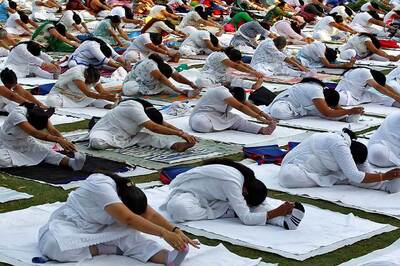
views
New Delhi: When Xi Jinping flew from Chennai to Kathmandu on Saturday, he became the first Chinese President to visit Nepal in 23 years. On Sunday, he rounded up the trip by signing as many as 20 agreements with Nepalese Prime Minister KP Sharma Oli, including the building of a road tunnel and a feasibility study of a railway link to Tibet. While Oli’s time in office has been marked with Nepal’s growing closeness to China, India has worked hard not to be outdone. During his first time in office, Prime Minister Narendra Modi visited Nepal thrice. As the two Asian giants race to Kathmandu, Nepal now sees opportunity in balancing both the relationships.
The biggest highlight of President Xi’s visit to Nepal was that both sides agreed to get started on the $2.75 billion trans-Himalayan connectivity network, which is Nepal’s link to Xi’s dream project – the Belt and Road Initiative (BRI). One of the agreements was that they would start building a road tunnel to connect the Nepalese capital to China border and another agreement said they would launch a joint “feasibility study” on building a rail network as well.
A Nepal government source said they hope to rebuild the entire road in the next 4 to 5 years with Chinese aid. “Right now, the road from Kathmandu to the China border is so bad that it will take us around six hours to get there. When the new road is ready, and we are hoping it will be in the next 4-5 years, we will get there in about two hours,” the source said.
The big shift in relations came in 2016 when Prime Minister Oli visited China. The two sides signed many landmark agreements, including one which would allow Chinese fuel in Nepal. This need for a pivot to China was brought on by the 2015 blockade. For six months, Madhesi community protestors, upset at being handed a raw deal by the Constitution, had blocked the India-Nepal border and the Nepalese government had accused India of encouraging the blockade, an allegation that India denied. This triggered an economic crisis in the Himalayan republic as fuel shortages crippled Nepal. This period saw anti-India protests in Nepal and even saw some protestors burning effigies of Prime Minister Modi, which India strongly objected to.
India still remains the largest investor in the Nepalese economy. Apart from the possibility of a rail link between Raxaul and Kathmandu, India has also invested heavily in the energy and education sectors in Nepal – far more than China has. But there has been a realisation that Nepal needs to reduce its dependence on India.
But even as China builds the road to Kathmandu and India gets started on a rail link between Raxaul in Bihar to the Nepalese capital, Nepal has begun to see its role as a future link between India and China. The Nepal government source added, “We are a nation of just three crore people. China is not interested in Nepal as a standalone market. It is interested in the Indian states of Uttar Pradesh and Bihar. Those are the big markets for Chinese goods.”
With a combined population of over 30 crore, Bihar and UP together form a population more than 10 times that of Nepal’s. The trans-Himalayan connectivity network would be a direct link between Tibet and UP-Bihar. Eventually, hopes the Nepal government, it would be a way for Nepal to profit off of this arrangement. That is also why Nepal has been hoping for a trilateral trade agreement to emerge between the three nations.
But representatives of the KP Sharma Oli government say that Oli’s time in office has not just meant closer ties with both nations. Under Oli, Nepal has begun to create a more global approach to foreign policy. Having served two terms, Oli is already the longest serving Prime Minister of Nepal since the monarchy ended in 2008.
“We are building a strong relationship with nations around the world. We have had bilateral meetings with leaders from across the world, including those of US, Japan and France. Our Foreign Minister recently had a very successful bilateral meeting with US Secretary of State Mike Pompeo,” said Roshan Khadka, press coordinator for the Nepalese ministry of energy, adding, “We don’t want to be dependent on any one country. We want to have a broader relationship with nations around the world. Yet, we maintain that we have a special relationship with India and China. They will remain our closest friends as they are our neighbours.”
When asked if by hyphenating India and China, the Nepal government wants to put both neighbours on the same pedestal, Khadka said, “It is wrong to say that closer ties with China would mean weaker ties with India or vice-versa. Yes, there were some tensions between India and Nepal in 2015, but all neighbours have them. Prime Ministers Modi and Oli have worked hard to repair that relationship and our friendship with India remains strong. Nepal is an independent, sovereign nation that will decide its dynamics with each nation based on its own interests.”
--


















Comments
0 comment